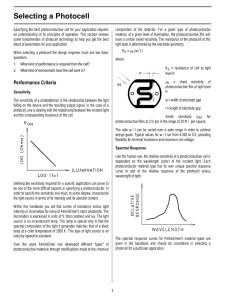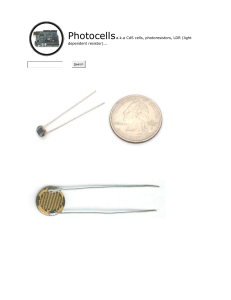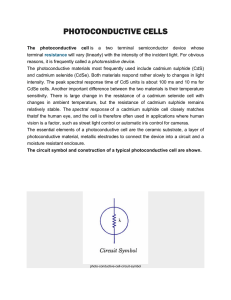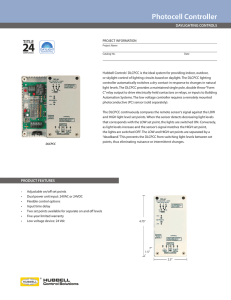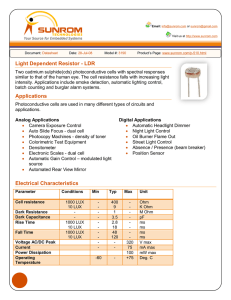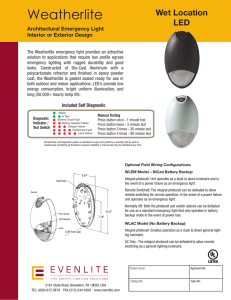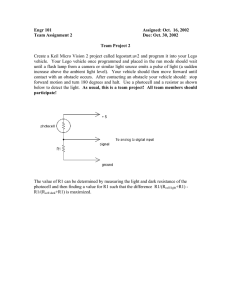Photoconductive Cells
advertisement
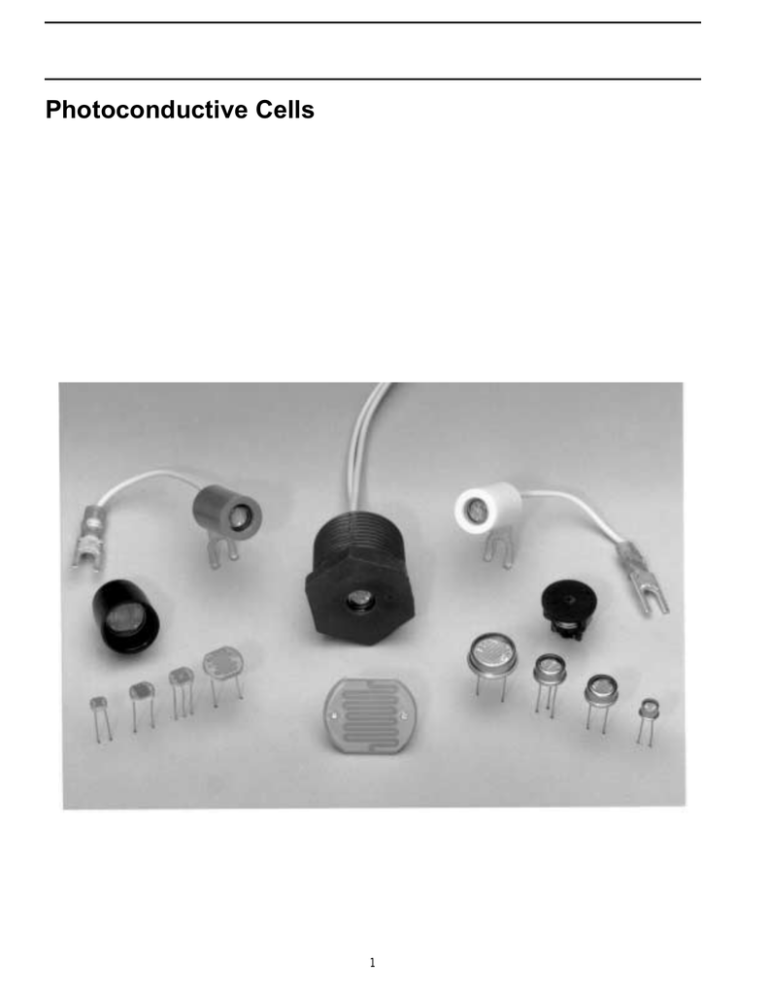
Photoconductive Cells 1 What is a Photoconductive Cell? Semiconductor light detectors can be divided into two major categories: junction and bulk effect devices. Junction devices, when operated in the photoconductive mode, utilize the reverse characteristic of a PN junction. Under reverse bias, the PN junction acts as a light controlled current source. Output is proportional to incident illumination and is relatively independent of implied voltage as shown in Figure 1. Silicon photodiodes are examples of this type detector. Figure 2 Bulk Effect Photoconductor (Photocell) In contrast, bulk effect photoconductors have no junction. As shown in Figure 2, the bulk resistivity decreases with increasing illumination, allowing more photocurrent to flow. This resistive characteristic gives bulk effect photoconductors a unique quality: signal current from the detector can be varied over a wide range by adjusting the applied voltage. To clearly make this distinction, PerkinElmer Optoelectronics refers to it’s bulk effect photoconductors as photoconductive cells or simply photocells. Photocells are thin film devices made by depositing a layer of a photoconductive material on a ceramic substrate. Metal contacts are evaporated over the surface of the photoconductor and external electrical connection is made to these contacts. These thin films of photoconductive material have a high sheet resistance. Therefore, the space between the two contacts is made narrow and interdigitated for low cell resistance at moderate light levels. This construction is shown in Figure 3. Figure 1 Junction Photoconductor (Photodiode) Figure 3 Typical Construction of a Plastic Coated Photocell 2 Photoconductive Cell Typical Applications Why Use Photocells? Photocells can provide a very economic and technically superior solution for many applications where the presence or absence of light is sensed (digital operation) or where the intensity of light needs to be measured (analog operation). Their general characteristics and features can be summarized as follows: • Lowest cost available and near-IR photo detector • Available in low cost plastic encapsulated packages as well as hermetic packages (TO-46, TO-5, TO-8) • Responsive to both very low light levels (moonlight) and to very high light levels (direct sunlight) • Wide dynamic range: resistance changes of several orders of magnitude between "light" and "no light" • Low noise distortion • Maximum operating voltages of 50 to 400 volts are suitable for operation on 120/240 VAC • Available in center tap dual cell configurations as well as specially selected resistance ranges for special applications • Easy to use in DC or AC circuits - they are a light variable resistor and hence symmetrical with respect to AC waveforms • Usable with almost any visible or near infrared light source such as LEDS; neon; fluorescent, incandescent bulbs, lasers; flame sources; sunlight; etc • Available in a wide range of resistance values Applications Photoconductive cells are used in many different types of circuits and applications. Analog Applications • Camera Exposure Control • Auto Slide Focus - dual cell • Photocopy Machines - density of toner • Colorimetric Test Equipment • Densitometer • Electronic Scales - dual cell • Automatic Gain Control - modulated light source • Automated Rear View Mirror Digital Applications • Automatic Headlight Dimmer • Night Light Control • Oil Burner Flame Out • Street Light Control • Absence / Presence (beam breaker) • Position Sensor 3 Photoconductive Cell Typical Application Circuits Ambient Light Measurement Camera Exposure Meter (VT900) Brightness Control (VT900) DC Relay Rear View Mirror Control (VT200) Head Light Dimmer (VT300 or VT800) AC Relay Night Light Control (VT800 or VT900) Street Light Control (VT400) Flame Detector (VT400 or 500) Object Sensing / Measurement Beam Breaking Applications (VT800) Security Systems (VT800 or VT900) Colorimetric Test Equipment (VT200 or VT300) Densitometer (VT200 or VT300) Bridge Circuits Auto Focus (VT300CT or VT800CT) Electronic Scales (VT300CT or VT800CT) Photoelectric Servo (VT300CT or VT800CT) 4 Selecting a Photocell composition of the detector. For a given type of photoconductor material, at a given level of illumination, the photoconductive film will; have a certain sheet resistivity. The resistance of the photocell at this light level is determined by the electrode geometry. Specifying the best photoconductive cell for your application requires an understanding of its principles of operation. This section reviews some fundamentals of photocell technology to help you get the best blend of parameters for your application. RH = ρH (w / l ) When selecting a photocell the design engineer must ask two basic questions: 1. What kind of performance is required from the cell? 2. What kind of environment must the cell work in? where: RH = resistance of cell at light level H ρH = sheet resistivity of photoconductive film at light level H Performance Criteria Sensitivity w = width of electrode gap The sensitivity of a photodetector is the relationship between the light falling on the device and the resulting output signal. In the case of a photocell, one is dealing with the relationship between the incident light and the corresponding resistance of the cell. l = length of electrode gap Sheet sensitivity (ρH) for photoconductive films at 2 fc are in the range of 20 MΩ per square. The ratio w / l can be varied over a wide range in order to achieve design goals. Typical values for w / l run from 0.002 to 0.5, providing flexibility for terminal resistance and maximum cell voltage. Spectral Response Like the human eye, the relative sensitivity of a photoconductive cell is dependent on the wavelength (color) of the incident light. Each photoconductor material type has its own unique spectral response curve or plot of the relative response of the photocell versus wavelength of light. Defining the sensitivity required for a specific application can prove to be one of the more difficult aspects in specifying a photoconductor. In order to specify the sensitivity one must, to some degree, characterize the light source in terms of its intensity and its spectral content. Within this handbook you will find curves of resistance versus light intensity or illumination for many of PerkinElmer’s stock photocells. The illumination is expressed in units of fc (foot candles) and lux. The light source is an incandescent lamp. This lamp is special only in that the spectral composition of the light it generates matches that of a black body at a color temperature of 2850 K. This type of light source is an industry agreed to standard. The spectral response curves for PerkinElmer’s material types are given in the handbook and should be considered in selecting a photocell for a particular application. Over the years PerkinElmer has developed different “types” of photoconductive materials through modifications made to the chemical 5 Selecting a Photocell Slope Characteristics Plots of the resistance for the photocells listed in this catalog versus light intensity result in a series of curves with characteristically different slopes. This is an important characteristic of photocells because in many applications not only is the absolute value of resistance at a given light level of concern but also the value of the resistance as the light source is varied. One way to specify this relationship is by the use of parameter (gamma) which is defined as a straight line passing through two specific points on the resistance curve. The two points used by PerkinElmer to define γ are 10 lux (0.93 fc) and 100 lux (9.3 fc). Likewise, for dual element photocells the matching factor, which is defined as the ratio of the resistance of between elements, will increase with decreasing light level. Log Ra – Log Rb γ = ------------------------------------Log a – Lob b Dual Element Photocell Typical Matching Ratios Log ( Ra ⁄ Rb ) = -----------------------------Log ( b ⁄ a ) 0.01 fc 0.1 fc 1.0 fc 10 fc 100 fc 0.63 – 1.39 0.74 – 1.27 0.75 – 1.25 0.76 – 1.20 0.77 – 1.23 Dark Resistance As the name implies, the dark resistance is the resistance of the cell under zero illumination lighting conditions. In some applications this can be very important since the dark resistance defines what maximum “leakage current” can be expected when a given voltage is applied across the cell. Too high a leakage current could lead to false triggering in some applications. Applications for photocells are of one of two categories: digital or analog. For the digital or ON-OFF types of applications such as flame detectors, cells with steep slopes to their resistance versus light intensity curves are appropriate. For analog or measurement types of applications such as exposure controls for cameras, cells with shallow slopes might be better suited. The dark resistance is often defined as the minimum resistance that can be expected 5 seconds after the cell has been removed from a light intensity of 2 fc. Typical values for dark resistance tend to be in the 500k ohm to 20M ohm range. Temperature Coefficient of Resistance. Resistance Tolerance Each type of photoconductive material has its own resistance versus temperature characteristic. Additionally, the temperature coefficients of photoconductors are also dependent on the light level the cells are operating at. The sensitivity of a photocell is defined as its resistance at a specific level of illumination. Since no two photocells are exactly alike, sensitivity is stated as a typical resistance value plus an allowable tolerance. Both the value of resistance and its tolerance are specified for only one light level. For moderate excursions from this specified light level the tolerance level remain more or less constant. However, when the light level the tolerance level remain more or less constant. However, when the light level is decades larger or smaller than the reference level the tolerance can differ considerably. From the curves of the various types of materials it is apparent that the temperature coefficient is an inverse funstin of light level. Thus, in order to minimize temperature problems it is desirable to have the cell operating at the highest light level possible. Speed of Response As the light level decreases, the spread in the tolerance level increases. For increasing light levels the resistance tolerance will tighten. Speed of response is a measure of the speed at which a photocell responds to a change from light-to-dark or from dark-to-light. The rise time is defined as the time necessary for the light conductance of the photocell to reach 1-1/e (or about 63%) of its final value. 6 Selecting a Photocell The decay or fall time is defined as the time necessary for the light conductance of the photocell to decay to 1/e (or about 73%) of its illuminated state. At 1 fc of illumination the response times are typically in the range of 5 msec to 100 msec. This guide illustrates the fact that a photocell which has been stored for a long time in the light will have a considerably higher light resistance than if it was stored for a long time in the dark. Also, if a cell is stored for a long period of time at a light level higher than the test level, it will have a higher light resistance than if it was stored at a light level closer to the test light level. The speed of response depends on a number of factors including light level, light history, and ambient temperature. All material types show faster speed at higher light levels and slower speed at lower light levels. Storage in the dark will cause slower response than if the cells are kept in the light. The longer the photocells are kept in the dark the more pronounced this effect will be. In addition, photocells tend to respond slower in colder temperatures. This effect can be minimized significantly by keeping the photocell exposed to some constant low level of illumination (as opposed to having it sit in the dark). This is the reason resistance specifications are characterized after 16 hours light adept. Environmental/Circuitry Considerations Light History All photoconductive cells exhibit a phenomenon known as hysteresis, light memory, or light history effect. Simply stated, a photocell tends to remember its most recent storage condition (light or dark) and its instantaneous conductance is a function of its previous condition. The magnitude of the light history effect depends upon the new light level, and upon the time spent at each of these light levels. this effect is reversible. Packaging To understand the light history effect, it is often convenient to make an analogy between the response of a photocell and that of a human eye. Like the cell, the human eye’s sensitivity to light depends on what level of light it was recently exposed to. Most people have had the experience of coming in from the outdoors on a bright summer’s day and being temporarily unable to see under normal room levels of illumination. your eyes will adjust but a certain amount of time must elapse first. how quickly one’s eyes adjust depends on how bright it was outside and how long you remained outdoors. The disadvantage of plastic coatings is that they are not an absolute barrier to eventual penetration by moisture. This can have an adverse effect on cell life. However, plastic coated photocells have been used successfully for many years in such hostile environments as street light controls. In order to be protected from potentially hostile environments photocells are encapsulated in either glass/metal (hermetic) package or are covered with a clear plastic coating. While the hermetic packages provide the greatest degree of protection, a plastic coating represents a lower cost approach. Temperature Range The chemistry of the photoconductive materials dictates an operating and storage temperature range of –40°C to 75°C. It should be noted that operation of the cell above 75°C does not usually lead to catastrophic failure but the photoconductive surface may be damaged leading to irreversible changes in sensitivity. The following guide shows the general relationship between light history and light resistance at various light levels. The values shown were determined by dividing the resistance of a given cell, following infinite light history (RLH), by the resistance of the same cell following “infinite” dark history (RDH). For practical purposes, 24 hours in the dark will achieve RDH or 24 hours at approximately 30 fc will achieve RLH. The amount of resistance change is a function of time as well as temperature. While changes of several hundred percent will occur in a matter of a few minutes at 150°C, it will take years at 50°C to produce that much change. Power Dissipation Typical Variation of Resistance with Light History Expressed as a Ratio RLH / RDH at Various Test Illumination Levels. During operation, a cell must remain within its maximum internal temperature rating of 75°C. Any applied power will raise the cell’s temperature above ambient and must be considered. Illumination RLH / RDH Ratio 0.01 fc 0.1 fc 1.0 fc 10 fc 100 fc 1.55 1.35 1.20 1.10 1.10 7 Selecting a Photocell Maximum Cell Voltage Many low voltage situations involve very little power, so that the photocell can be small in size, where voltages and/or currents are higher, the photocell must be physically larger so that the semiconductor film can dissipate the heat. At no time should the peak voltage of the cell exceed its maximum voltage. the designer should determine the maximum operating or peak voltage that the cell will experience in the circuit and choose an appropriately rated cell. Typical voltage rates range from 100V to 300V. The following curve of power dissipation versus ambient temperature describes the entire series of cells for operation in free air at room ambient (25°C). Note that regardless the size, all photocells derate linearly to zero at an ambient temperature of 75°C. The adequate heat sinks can increase the dissipation by as much as four times the levels shown in this graph. What Type of Material is Best? Each specific material type represents a trade off between several characteristics. Selecting the best material is a process of determining which characteristics are most important tin the application. PerkinElmer’s standard photocells in this catalog are manufactured using one of two different material types offered: type “Ø” or type “3”. In general, material type “Ø” is used for applications such as nightlights, automotive sensors. Material type “3” is primarily used in camera, streetlight control, and flame detector applications. 8 Photoconductive Cell Typical Characteristic Curves @ 25°C Type Ø Material Type Ø Material This is a general purpose material. Its characteristics include a good temperature coefficient and fast response time, especially at very low light levels. Cells of this type have relatively low dark history. Type Ø material is often used in lighting controls such as nightlights, and security lighting. The resistance for any standard catalog cell is controlled at only one light level. If the resistance at other light levels is a concern, please contact the factory. To obtain the typical resistance versus illumination characteristic for a specific part number: Resistance vs. Illumination 1. Look up 2 footcandle resistance in table. 2. Insert resistance given and draw a curve through that point and parallel to the closest member of the family of curves shown for the appropriate type of photo-sensitive material. Response Time vs. Illumination (Rise Time) Response Time vs. Illumination (Decay Time) 9 Photoconductive Cell Typical Characteristic Curves @ 25°C Type Ø Material Relative Spectral Response Relative Resistance vs. Temperature 10 Photoconductive Cell Typical Characteristic Curves @ 25°C Type 3 Material Type 3 Material This is a high speed material with a spectral response closely approximating the human eye. This material is well suited for switching from one light level to another and offers our best temperature stability and response time. This material is often used in cameras and industrial controls. The resistance for any standard catalog cell is controlled at only one light level. If the resistance at other light levels is a concern, please contact the factory. To obtain the typical resistance versus illumination characteristic for a specific part number: Resistance vs. Illumination 1. Look up 2 footcandle resistance in table. 2. Insert resistance given and draw a curve through that point and parallel to the closest member of the family of curves shown for the appropriate type of photo-sensitive material. Response Time vs. Illumination (Rise Time) Response Time vs. Illumination (Decay Time) 11 Photoconductive Cell Typical Characteristic Curves @ 25°C Type 3 Material Relative Spectral Response Relative Resistance vs. Temperature 12 Photoconductive Cell Testing and General Notes Production Testing of Photocells - PerkinElmer’s New Approach Historically within this industry, vendors have set their production testers to the limits specified on the customer’s print. Measurement errors due to ambient temperature, calibration of light source, light history effect, plus any tester errors have always guaranteed that a certain percentage of the cells shipped are out of specification. This practice is incompatible with the realities of today’s marketplace, where quality levels are being measured in parts per million. With this new catalog, PerkinElmer is taking the opportunity to correct this situation. for parts in this catalog, PerkinElmer has pulled in the test limits on our production testers to compensate for measurement errors. General Notes (Refer to the following data specification pages.) Photocells are supplied categorized into groups by resistance. All groups must be purchased together and PerkinElmer maintains the right to determine the product mix among these groups. 1 2 Dimension controlled at base of package. 3 Photocells are tested at either 1 fc or 10 lux. 2 fc typical values shown in the tables are for reference only. 4 Cells are light adapted at 30 - 50 fc. The photocell “grid” pattern can vary from that shown. PerkinElmer reserves the right to change mix grid patterns on any standard product. 5 The resistance for any standard cell is controlled at only one light level. If the resistance at other light levels is a concern, please contact the factory. 6 13
